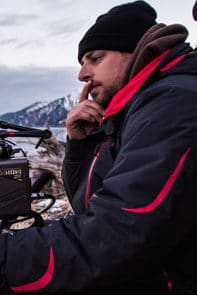03
Delia
Shot By: John Garrett
2nd Assistant

John Garrett | 2nd Assistant
John Garrett grew up in San Francisco as the son of a theatrical-lighting-designer father and a ballerina-and-modern-dancer mother. While his peers were sleeping in their own beds every night, John was playing on the stage and sleeping under the dimmer-board table as his parents worked on shows in different theaters around town. In his teens, John’s dad would go on to do theatrical lighting jobs on movie sets. John got to visit him on Leap of Faith, Strange Days, Batman Forever, The Birdcage and others. He was hooked and knew working on movies was what he wanted to do.
After graduating from the University of California at Santa Barbara (UCSB) with a degree in film, John moved to Los Angeles, where he was advised to get a job at Panavision if he wanted to get into the camera department. He started in Shipping and Receiving and worked his way up to prep tech. A couple of camera assistants took a liking to John and invited him to camera-PA on their show after work on the nights and weekends. He is forever grateful to Richie Masino and Darin Moran for giving him that first shot. After John got in the Union, he hooked up with “the greatest focus puller in the world,” Jimmy Jensen. Jimmy gave John the best old-school training anyone could ever dream of. John still has not met anyone who works harder, with more passion and skill than Jimmy.
John met the director of Delia, Thomas Scott Stanton, working as Jimmy’s 2nd AC on Dreamgirls. In the years since, the two have become great friends and regular collaborators on various projects. Delia is a heavy story about the aftermath of a hunting accident. John felt Thomas was the perfect leader to guide this difficult story with passion and humanity. The two shot on the Red Epic camera and on four super-speed primes. The large, fluffy snowflakes of the New Hampshire winter provided an immaculate backdrop for the lead character’s anguish. Thomas and John spoke about a naturalistic and unobtrusive shooting approach, used no movie lights, and tried to give the actors and camera some distance. A motif the two employed was what they called the “missing passenger shot,” where the camera would take the position the absent daughter usually occupied: the pickup-truck passenger seat, her usual seat at the dinner table, etc. and voyeuristically observe the lead character fall apart.
John says, “It’s great to feel supported and encouraged with something like the Emerging Cinematographers Awards. I’m very grateful for the recognition and humbled by the honor.”